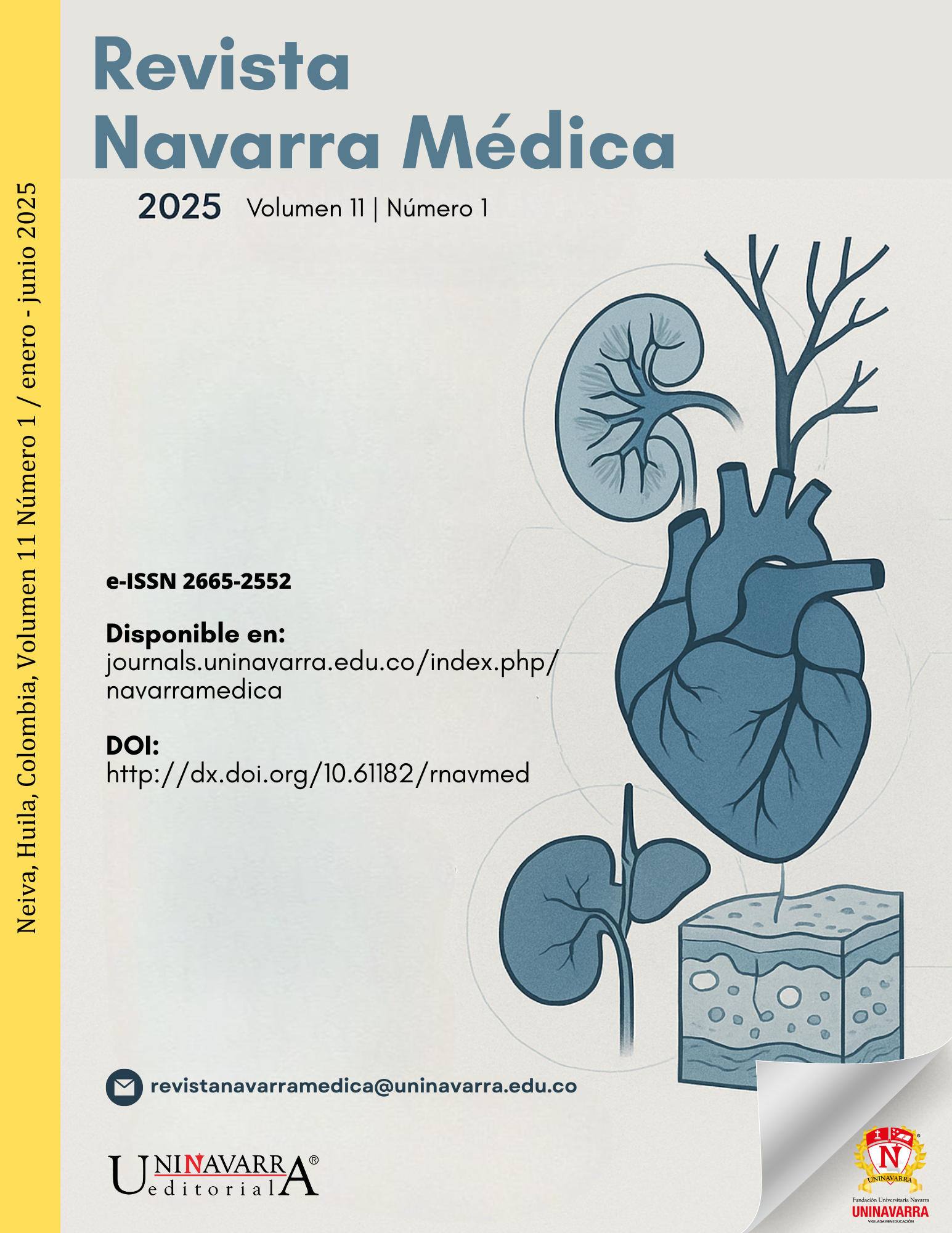Amyloidosis and bleeding: a case report
DOI:
https://doi.org/10.61182/rnavmed.v11n1a5Keywords:
Systemic Amyloidosis, Bleeding, Deficiency, Coagulation Factors, VasculopathyAbstract
Introduction: Amyloidosis is a group of diseases caused by the deposition of misfolded proteins in various organs, potentially leading to bleeding — a rare but serious complication.
Case: A 41-year-old man with AL kappa amyloidosis presented with spontaneous intra-abdominal bleeding, associated with coagulation factor deficiencies and hemostatic alterations. Despite transfusion support, antifibrinolytics, and vitamin K administration, the patient’s condition worsened, and he died.
Discussion: Bleeding in amyloidosis may result from multiple combined mechanisms, such as acquired coagulation factor deficiencies and vascular dysfunction, making management challenging.
Conclusions: Although rare, bleeding in amyloidosis can be fatal; early recognition and comprehensive treatment are essential.
References
1. Posadas, ML, Aguirre MA, Belziti C, Brouet E, Auteri MA, Forte AL, et al. Guía de Práctica Clínica para el diagnóstico de la amiloidosis: Parte 1/3. Año 2020. Rev Fac Cien Med Univ Nac Córdoba. 2021;78(1):74-82. https://doi.org/10.31053/1853.0605.v78.n1.30824
2. Nicol M, Siguret V, Vergaro G, Aimo A, Emdin M, Dillinger JG, et al. Thromboembolism and bleeding in systemic amyloidosis: A review. ESC Heart Fail. 2022;9(1):11–20. https://doi.org/10.1002/ehf2.13701
3. Abdallah N, Muchtar E, Dispenzieri A, Gonsalves W, Buadi F, Lacy MQ, et al. Coagulation abnormalities in light chain amyloidosis. Mayo Clin Proc. 2021;96(2):320-30. https://doi.org/10.1016/j.mayocp.2020.06.061
4. Sucker C, Hetzel GR, Grabensee B, Stockschlaeder M, Scharf RE. Amyloidosis and bleeding: Pathophysiology, diagnosis, and therapy. Am J Kidney Dis. 2006;47(6):947-55. https://doi.org/10.1053/j.ajkd.2006.03.036
5. Thompson CA, Kyle R, Gertz M, et al. Systemic AL amyloidosis with acquired factor X deficiency: A study of perioperative bleeding risk and treatment outcomes in 60 patients. Am J Hematol. 2010;85(3):171–173. https://doi.org/10.1002/ajh.21603
6. Ericson S, Shah N, Liberman J, Aboulafia DM. Fatal bleeding due to acquired factor IX and X deficiency: a rare complication of primary amyloidosis; case report and review of the literature. Clin Lymphoma Myeloma Leuk. 2014; 14:e81. https://doi.org/10.1016/j.clml.2013.08.007
7.Kos CA, Ward JE, Malek K, et al. Association of acquired von Willebrand syndrome with AL amyloidosis. Am J Hematol 2007; 82:363. https://doi.org/10.1002/ajh.20829
8. Emori Y, Sakugawa M, Niiya K, Kiguchi T, Kojima K, Takenaka K, et al. Life-threatening bleeding and acquired factor V deficiency associated with primary systemic amyloidosis. Blood Coagul Fibrinolysis. 2002;13(6):555-9. https://doi.org/10.1097/00001721-200209000-00011
9. Wiest, R., Klouche, M., Härle, P. et al. Acquired combined factor X and XII deficiency with isolated bleeding complications in a patient with AL amyloidosis. Ann Hematol. 2005;84(3):196-9. https://doi.org/10.1007/s00277-004-0970-8
10. McPherson RA, Onstad JW, Ugoretz RJ, Wolf PL. Coagulopathy in amyloidosis: combined deficiency of factors IX and X. Am J Hematol. 1977;3:225-35. https://doi.org/10.1002/ajh.2830030303
11. Hoffman JE, Dempsey NG, Sanchorawala V. Systemic Amyloidosis Caused by Monoclonal Immunoglobulins: Soft Tissue and Vascular Involvement. Hematol Oncol Clin North Am 2020; 34:1099. https://doi.org/10.1016/j.hoc.2020.08.004
12. Gastineau DA, Gertz MA, Daniels TM, Kyle RA, Bowie EJ. Inhibitor of the thrombin time in systemic amyloidosis: a common coagulation abnormality. Blood. 1991 Jun 15;77(12):2637-40
13. Choufani EB, Sanchorawala V, Ernst T, Quillen K, Skinner M, Wright DG, Seldin DC. Acquired factor X deficiency in patients with amyloid light-chain amyloidosis: incidence, bleeding manifestations, and response to high-dose chemotherapy. Blood. 2001; 97(6):1885-7. https://doi.org/10.1182/blood.v97.6.1885
14. Mumford AD, O'Donnell J, Gillmore JD, Manning RA, Hawkins PN, Laffan M. Bleeding symptoms and coagulation abnormalities in 337 patients with AL-amyloidosis. Br J Haematol. 2000;110(2):454-60. https://doi.org/10.1046/j.1365-2141.2000.02183.x
15. Charyev BM, et al. Characteristics of the aggregative function of thrombocytes in amyloidosis.Ter Arkh. 1988;60(6):85-8.
16. Kvolik S, Jukic M, Matijevic M, Marjanovic K, Glavas-Obrovac L. An overview of coagulation disorders in cancer patients. Surg Oncol. 2010;19(1):e33-46. https://doi.org/10.1016/j.suronc.2009.03.008
17. Gamba G, Montani N, Anesi E, Palladini G, Capezzera M, Soldavini E, Merlini G. Clotting alterations in primary systemic amyloidosis. Haematologica. 2000;85(3):289-92. https://pubmed.ncbi.nlm.nih.gov/10702818/
18. Suga N, Miura N, Kitagawa W, et al. Differential diagnosis of localized and systemic amyloidosis based on coagulation and fibrinolysis parameters. Amyloid. 2012;19(2):61-5. https://doi.org/10.3109/13506129.2012.663425
19. Ikeda SI. Cerebral amyloid angiopathy with familial transthyretin-derived oculoleptomeningeal amyloidosis. Brain Nerve. 2013; 65(7):831. https://pubmed.ncbi.nlm.nih.gov/23832986/
20. Vinters HV, Gilbert JJ. Cerebral amyloid angiopathy: incidence and complications in the aging brain. II. The distribution of amyloid vascular changes. Stroke. 1983;14(6):924-8. https://doi.org/10.1161/01.str.14.6.924
21. Jäkel, L. et al. Prevalence of cerebral amyloid angiopathy: A systematic review and meta-analysis. Alzheimer's & Dementia. 2021; 18(1):10-28. https://doi.org/10.1002/alz.12366
22. Bucurica S, Nancoff AS, Moraru MV, Bucurica A, Socol C, Balaban DV, Mititelu MR, Maniu I, Ionita-Radu F, Jinga M. Digestive Amyloidosis Trends: Clinical, Pathological, and Imaging Characteristics. Biomedicines. 2024; 12(11):2630. https://doi.org/10.3390/biomedicines12112630
23. Syed U, Ching Companioni RA, Alkhawam H, Walfish A. Amyloidosis of the gastrointestinal tract and the liver: clinical context, diagnosis and management. Eur J Gastroenterol Hepatol. 2016; 28:1109. https://doi.org/10.1097/meg.0000000000000695
24. Claveau JS, Wetter DA, Kumar S. Cutaneous manifestations of monoclonal gammopathy. Blood Cancer J. 2022 Apr 11;12(4):58. https://doi.org/10.1038/s41408-022-00661-1
25. Takabe K, Holman PR, Herbst KD, Glass CA, Bouvet M. Successful perioperative management of factor X deficiency associated with primary amyloidosis. J Gastrointest Surg. 2004;8(3):358-62. https://doi.org/10.1016/j.gassur.2003.10.014
26. Boggio L, Green D. Recombinant human factor VIIa in the management of amyloid-associated factor X deficiency. Br J Haematol 2001; 112(4):1074. https://doi.org/10.1046/j.1365-2141.2001.02667.x
27. Matsumoto G, Mori H, Mori T, Sakaki C. Clinical effects of tranexamic acid on bleeding tendency due to fibrinolytic activation of AL amyloidosis. BMJ Case Rep. 2023;16(9):e254483. https://doi.org/10.1136/bcr-2022-254483
28. Arahata M, Takamatsu H, Morishita E, Kadohira Y, Yamada S, Ichinose A, Asakura H. Coagulation and fibrinolytic features in AL amyloidosis with abnormal bleeding and usefulness of tranexamic acid. Int J Hematol. 2020;111(4):550-558. https://doi.org/10.1007/s12185-019-02811-x
29. Breems DA, Sonneveld P, de Man RA, Leebeek FW. Successful treatment of systemic amyloidosis with hepatic involvement and factor X deficiency by high dose melphalan chemotherapy and autologous stem cell reinfusion. Eur J Haematol. 2004;72(3):181-5. https://doi.org/10.1046/j.0902-4441.2003.00200.x
30. Camoriano JK, Greipp PR, Bayer GK, Bowie EJ. Resolution of acquired factor X deficiency and amyloidosis with melphalan and prednisone therapy. N Engl J Med. 1987;316(18):1133-5. https://doi.org/10.1056/nejm198704303161806
Downloads
Published
Data Availability Statement
If you require additional information about the clinical case, please contact the corresponding author via e-mail.
Issue
Section
License
Copyright (c) 2025 Cristina Zurique-Sanchez, Leonardo Solis-Parra, Fabio De la Hoz-Guerra, Marina Zurique-Sánchez, Marina Sánchez-Sanabria, Evelin Herrera

This work is licensed under a Creative Commons Attribution-NonCommercial 4.0 International License.








